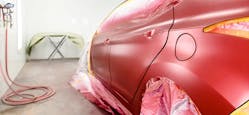As waterborne paint becomes mainstream in the automotive refinish industry and more common for industrial finishing applications, it is crucial to understand how it differs from solvent-based paint, as well as what you need to do to protect your facility and painters.
While the transition from solvent-based paint to waterborne may seem expensive upfront, the costs are justified by creating a healthier work environment for painters, in addition to the environmental benefits. Other perks of waterborne paint include its cleaner, brighter appearance, and ability to more easily color match.
Transitioning to waterborne
When using waterborne, the paint guns must be made of corrosion-resistant materials. They also must be cleaned with waterborne-specific cleaners, as waterborne paint sticks in places more often than solvent-based paint does. Paint guns designed only for solvent-based paint cannot be used with waterborne.
Curing time for waterborne can be significantly longer than curing time for solvent-based coatings. To avoid a bottleneck in production due to the increased drying time, manufacturing or refinishing processes may need to be adjusted. Options for auto body shops and collision repair centers include AdvanceCure Accelerated Airflow Systems and REVO Accelerated Curing Systems from Global Finishing Solutions (GFS) — time-saving technologies that drastically shorten repair cycle time.
Humidity control is essential with waterborne paint. Unlike solvent-based paint, waterborne does not dry well on its own. Many waterborne paints require a low-humidity environment to assist the drying process.
The technical data sheet (TDS) of the coating you are using specifies the desired humidity level. Depending on the humidity level, different additives are required when spraying waterborne. Painters must learn how humidity affects waterborne paint and adjust accordingly. That is why representatives from paint companies typically spend a week or two training painters on how to use waterborne paint.
As you transition to waterborne paint, it may cost less in the long run because less waste is typically created compared to solvent-based paint. Additionally, less product is needed to cover the same area, waterborne paint color matches better, and it usually lasts longer in sealed containers, which helps with inventory control.
Paint companies are heavily investing in the development of waterborne. As a result, waterborne has a more vivid hue than solvent-based paint. It also has a high-quality finish, which reduces the required amount of clearcoat.
Fewer VOCs from waterborne than solvent-based paint
Volatile organic compounds (VOCs) are carbon-based compounds in solvents that create flammable vapors when evaporated. They contribute to smog and ozone depletion when released directly into the atmosphere, and toxins can persist in the air long after painting is completed. Exposure to VOCs also can cause a range of health problems.
There are fewer solvents in waterborne paint, making it potentially less toxic. However, some solvents are still needed in waterborne paint to achieve the right consistency for application. Conventional basecoats possess a VOC solvent content of about 84 percent, with about 16 percent solids, while waterborne basecoats are comprised of about 70 percent water, about 20 percent solids, and about 10 percent solvents.
Since waterborne emits less VOCs than solvent-based paint, air quality is improved, and health risks to painters are reduced. It is still important to spray in a high-quality paint booth that meets fire and life safety standards and to always wear the appropriate level of personal protective equipment (PPE).
Fans are still required when spraying waterborne paint
Some may believe that an exhaust fan is not needed in a paint booth when spraying waterborne paint because of the lower emissions of VOCs, but this is not true. A ventless paint booth is not a viable option for containing VOCs or promoting adequate airflow. Even when using waterborne paint, solvents still exist in undercoats and topcoats, so an exhaust fan is needed.
“You need to have an exhaust fan to remove the flammable or combustible materials,” says Geoff Raifsnider, senior mechanical engineer at GFS. “Flammable or not, overspray is not something you want to be breathing. Plus, you don’t want overspray drifting around the product and landing where you don’t want it to.”
Regardless of whether you are spraying waterborne or solvent-based paint, good airflow within the breathing zone — the area immediately in front of a painter — is critical for his or her health. Downstream of the process, good airflow ensures you avoid high-concentration pockets of vapors that could become ignitable.
“If you are spraying and light a match in front of the spray gun, you could set the sprayed material on fire," Raifsnider says. "There is a flammable concentration of vapors in the area between you and what you are painting. The airflow around you and the piece you are painting dilutes the mists and vapors that are released during the spray process, so that they are not flammable or combustible downstream.”
As technology continues to advance, there may come a time when waterborne makes solvent-based paint a thing of the past. If you are new to using waterborne, or even if you have used it for a while, taking the time to educate yourself about the differences from solvent-based paint is essential for the safety of your operation, and whether you are spraying waterborne or solvent-based paint, a proper paint booth is needed to help ensure your facility and painters are protected.




